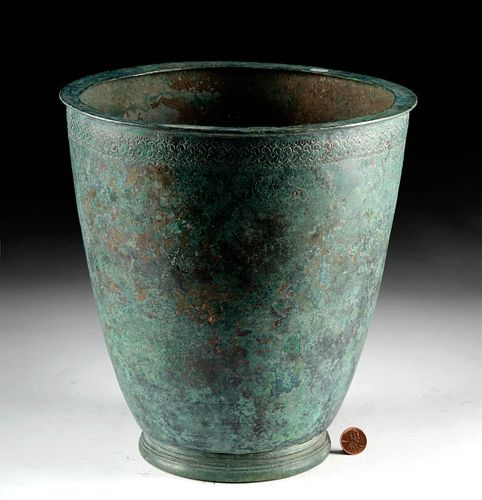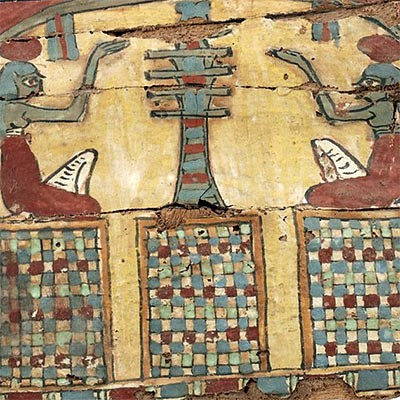Greek Hellenistic Bronze Situla w/ Incised Circles
Lot 21a
About Seller
Artemis Fine Arts
686 S Taylor Ave, Ste 106
Louisville, CO 80027
United States
Selling antiquities, ancient and ethnographic art online since 1993, Artemis Gallery specializes in Classical Antiquities (Egyptian, Greek, Roman, Near Eastern), Asian, Pre-Columbian, African / Tribal / Oceanographic art. Our extensive inventory includes pottery, stone, metal, wood, glass and textil...Read more
Categories
Estimate:
$7,000 - $10,500
Absentee vs Live bid
Two ways to bid:
- Leave a max absentee bid and the platform will bid on your behalf up to your maximum bid during the live auction.
- Bid live during the auction and your bids will be submitted real-time to the auctioneer.
Bid Increments
| Price | Bid Increment |
|---|---|
| $0 | $25 |
| $300 | $50 |
| $1,000 | $100 |
| $2,000 | $250 |
| $5,000 | $500 |
| $10,000 | $1,000 |
| $20,000 | $2,500 |
| $50,000 | $5,000 |
| $100,000 | $10,000 |
| $200,000 | $20,000 |
About Auction
By Artemis Fine Arts
Jul 30, 2020
Set Reminder
2020-07-30 10:00:00
2020-07-30 10:00:00
America/New_York
Bidsquare
Bidsquare : Ancient / Ethnographic From Around the World
https://www.bidsquare.com/auctions/artemis-gallery/ancient-ethnographic-from-around-the-world-5382
Ancient art from Egypt, Greece, Italy and the Near East, as well as Asian, Pre-Columbian, Native American, African / Tribal / Oceanic, Spanish Colonial, Russian Icons, Fine art, much more! All categories, all price ranges... all legally acquired and guaranteed to be as described or your money back. Artemis Fine Arts info@artemisgallery.com
Ancient art from Egypt, Greece, Italy and the Near East, as well as Asian, Pre-Columbian, Native American, African / Tribal / Oceanic, Spanish Colonial, Russian Icons, Fine art, much more! All categories, all price ranges... all legally acquired and guaranteed to be as described or your money back. Artemis Fine Arts info@artemisgallery.com
- Lot Description
Ancient Greece, early Hellenistic Period, ca. late 4th to 3rd century BCE. A stunning cast-bronze situla (Latin for bucket or pail) of a tapering cylindrical form, set atop a ridged pad base decorated with incised concentric circles underneath. The flaring walls gradually expand toward a flat overhanging rim, and a stamped register of guilloche enclosed by two bands of petite circles embellishes the area beneath the rim. Thick layers of green, brown, and russet patina envelop most of the interior and exterior of the vessel, though scattered areas of the beautiful original golden-brown bronze coloration is still visible. The situla form was originally created for cooling and serving wine at banquets, though others were used to hold ashes or offerings to be buried in tombs. Without decorative handles, this example was perhaps made specifically for mourning the dead. Size: 9.25" Diameter x 9.75" H (23.5 cm x 24.8 cm).
Cf. Mary Comstock & Cornelius Vermeule. "Greek, Etruscan & Roman Bronzes in the Museum of Fine Arts Boston." Boston, 1971, pp. 338-339, cat. no. 477.
A stylistically-similar example with a pair of handles hammered for $28,800 at Christie's, New York Antiquities auction (sale 1531, June 8, 2005, lot 109): https://www.christies.com/lotfinder/lot/a-greek-bronze-situla-hellenistic-period-circa-4505515-details.aspx?from=searchresults&intObjectID=4505515&sid=1593f119-0a44-4701-adc5-e919740a52a4
Provenance: private East Coast, USA collection; ex-Richard Wagner collection, Cape Cod, Massachusetts, USA, acquired in the 1960s
All items legal to buy/sell under U.S. Statute covering cultural patrimony Code 2600, CHAPTER 14, and are guaranteed to be as described or your money back.
A Certificate of Authenticity will accompany all winning bids.
We ship worldwide and handle all shipping in-house for your convenience.
#143839Large area of restoration to side of body, with resurfacing along new material. Slight bending to rim, minor abrasions and roughness to body, base, and rim, with some small pitting holes, and light encrustations. Nice earthen deposits as well as gorgeous green, russet, and brown patina throughout. Scattered areas of original bronze color are still visible.Condition
- Shipping Info
-
All shipping is handled in-house for your convenience. Your invoice from Artemis Gallery will include shipping calculation instructions. If in doubt, please inquire BEFORE bidding for estimated shipping costs for individual items.
-
- Buyer's Premium



 EUR
EUR CAD
CAD AUD
AUD GBP
GBP MXN
MXN HKD
HKD CNY
CNY MYR
MYR SEK
SEK SGD
SGD CHF
CHF THB
THB
















